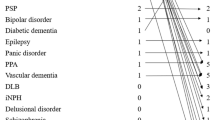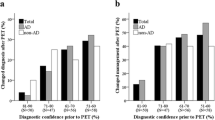Abstract
Purpose
In recent years, several [18F]-labeled amyloid-PET tracers have been developed and have obtained clinical approval. Despite their widespread scientific use, studies in routine clinical settings are limited. We therefore investigated the impact of [18F]-florbetaben (FBB)-PET on the diagnostic management of patients with suspected dementia that was still unclarified after [18F]-fluordeoxyglucose (FDG)-PET.
Methods
All subjects were referred in-house with a suspected dementia syndrome due to neurodegenerative disease. After undergoing an FDG-PET exam, the cases were discussed by the interdisciplinary dementia board, where the most likely diagnosis as well as potential differential diagnoses were documented. Because of persistent diagnostic uncertainty, the patients received an additional FBB-PET exam. Results were interpreted visually and classified as amyloid-positive or amyloid-negative, and we then compared the individual clinical diagnoses before and after additional FBB-PET.
Results
A total of 107 patients (mean age 69.4 ± 9.7y) were included in the study. The FBB-PET was rated as amyloid-positive in 65/107. In 83% of the formerly unclear cases, a final diagnosis was reached through FBB-PET, and the most likely prior diagnosis was changed in 28% of cases. The highest impact was observed for distinguishing Alzheimer’s dementia (AD) from fronto-temporal dementia (FTLD), where FBB-PET altered the most likely diagnosis in 41% of cases.
Conclusions
FBB-PET has a high additive value in establishing a final diagnosis in suspected dementia cases when prior investigations such as FDG-PET are inconclusive. The differentiation between AD and FTLD was particularly facilitated by amyloid-PET, predicting a considerable impact on patient management, especially in the light of upcoming disease-modifying therapies.





Similar content being viewed by others
References
Ziegler-Graham K, Brookmeyer R, Johnson E, Arrighi HM. Worldwide variation in the doubling time of Alzheimer's disease incidence rates. Alzheimers Dement. 2008;4:316–23. https://doi.org/10.1016/j.jalz.2008.05.2479.
Braak H, Braak E. Neuropathological stageing of Alzheimer-related changes. Acta Neuropathol. 1991;82:239–59.
Barthel H, Sabri O. Florbetaben to trace amyloid-beta in the Alzheimer brain by means of PET. J Alzheimers Dis. 2011;26(Suppl 3):117–21. https://doi.org/10.3233/JAD-2011-0068.
Sabri O, Sabbagh MN, Seibyl J, Barthel H, Akatsu H, Ouchi Y, et al. Florbetaben PET imaging to detect amyloid beta plaques in Alzheimer's disease: phase 3 study. Alzheimers Dement. 2015;11:964–74. https://doi.org/10.1016/j.jalz.2015.02.004.
Jack CR Jr, Bennett DA, Blennow K, Carrillo MC, Feldman HH, Frisoni GB, et al. A/T/N: an unbiased descriptive classification scheme for Alzheimer disease biomarkers. Neurology. 2016;87:539–47. https://doi.org/10.1212/WNL.0000000000002923.
Johnson KA, Minoshima S, Bohnen NI, Donohoe KJ, Foster NL, Herscovitch P, et al. Appropriate use criteria for amyloid PET: a report of the Amyloid imaging task force, the Society of Nuclear Medicine and Molecular Imaging, and the Alzheimer's Association. Alzheimers Dement. 2013;9:e-1-16. https://doi.org/10.1016/j.jalz.2013.01.002.
Vandenberghe R, Adamczuk K, Dupont P, Laere KV, Chetelat G. Amyloid PET in clinical practice: its place in the multidimensional space of Alzheimer's disease. Neuroimage Clin. 2013;2:497–511. https://doi.org/10.1016/j.nicl.2013.03.014.
Jansen WJ, Ossenkoppele R, Knol DL, Tijms BM, Scheltens P, Verhey FR, et al. Prevalence of cerebral amyloid pathology in persons without dementia: a meta-analysis. JAMA. 2015;313:1924–38. https://doi.org/10.1001/jama.2015.4668.
Dickerson BC, Bakkour A, Salat DH, Feczko E, Pacheco J, Greve DN, et al. The cortical signature of Alzheimer's disease: regionally specific cortical thinning relates to symptom severity in very mild to mild AD dementia and is detectable in asymptomatic amyloid-positive individuals. Cereb Cortex. 2009;19:497–510. https://doi.org/10.1093/cercor/bhn113.
Mosconi L, Tsui WH, Herholz K, Pupi A, Drzezga A, Lucignani G, et al. Multicenter standardized 18F-FDG PET diagnosis of mild cognitive impairment, Alzheimer's disease, and other dementias. J Nucl Med. 2008;49:390–8. https://doi.org/10.2967/jnumed.107.045385.
Bartlett JW, Frost C, Mattsson N, Skillback T, Blennow K, Zetterberg H, et al. Determining cut-points for Alzheimer's disease biomarkers: statistical issues, methods and challenges. Biomark Med. 2012;6:391–400. https://doi.org/10.2217/bmm.12.49.
Dubois B, Feldman HH, Jacova C, Cummings JL, Dekosky ST, Barberger-Gateau P, et al. Revising the definition of Alzheimer's disease: a new lexicon. Lancet Neurol. 2010;9:1118–27. https://doi.org/10.1016/S1474-4422(10)70223-4.
Petersen RC. Mild cognitive impairment as a diagnostic entity. J Intern Med. 2004;256:183–94. https://doi.org/10.1111/j.1365-2796.2004.01388.x.
Rascovsky K, Hodges JR, Knopman D, Mendez MF, Kramer JH, Neuhaus J, et al. Sensitivity of revised diagnostic criteria for the behavioural variant of frontotemporal dementia. Brain. 2011;134:2456–77. https://doi.org/10.1093/brain/awr179.
Gorno-Tempini ML, Hillis AE, Weintraub S, Kertesz A, Mendez M, Cappa SF, et al. Classification of primary progressive aphasia and its variants. Neurology. 2011;76:1006–14. https://doi.org/10.1212/WNL.0b013e31821103e6.
Patt M, Schildan A, Barthel H, Schultze-Mosgau MH, Rohde B, Reininger C, et al. Metabolite analysis of [18F]Florbetaben (BAY 94-9172) in human subjects: a substudy within a proof of mechanism clinical trial. J Radioanal Nucl Chem. 2010;284:557–62.
Barthel H, Gertz HJ, Dresel S, Peters O, Bartenstein P, Buerger K, et al. Cerebral amyloid-beta PET with florbetaben (18F) in patients with Alzheimer's disease and healthy controls: a multicentre phase 2 diagnostic study. Lancet Neurol. 2011;10:424–35. https://doi.org/10.1016/S1474-4422(11)70077-1.
Minoshima S, Frey KA, Koeppe RA, Foster NL, Kuhl DE. A diagnostic approach in Alzheimer's disease using three-dimensional stereotactic surface projections of fluorine-18-FDG PET. J Nucl Med: Off Publ Soc Nucl Med. 1995;36:1238–48.
Minoshima S, Drzezga AE, Barthel H, Bohnen N, Djekidel M, Lewis DH, et al. SNMMI procedure standard/EANM practice guideline for Amyloid PET imaging of the brain 1.0. J Nucl Med. 2016;57:1316–22. https://doi.org/10.2967/jnumed.116.174615.
Frederiksen KS, Hasselbalch SG, Hejl AM, Law I, Hojgaard L, Waldemar G. Added diagnostic value of (11)C-PiB-PET in memory clinic patients with uncertain diagnosis. Dement Geriatr Cogn Dis Extra. 2012;2:610–21. https://doi.org/10.1159/000345783.
Boccardi M, Altomare D, Ferrari C, Festari C, Guerra UP, Paghera B, et al. Assessment of the incremental diagnostic value of Florbetapir F 18 imaging in patients with cognitive impairment: the incremental diagnostic value of Amyloid PET with [18F]-Florbetapir (INDIA-FBP) study. JAMA Neurol. 2016; https://doi.org/10.1001/jamaneurol.2016.3751.
Grundman M, Pontecorvo MJ, Salloway SP, Doraiswamy PM, Fleisher AS, Sadowsky CH, et al. Potential impact of amyloid imaging on diagnosis and intended management in patients with progressive cognitive decline. Alzheimer Dis Assoc Disord. 2013;27:4–15. https://doi.org/10.1097/WAD.0b013e318279d02a.
Sanchez-Juan P, Ghosh PM, Hagen J, Gesierich B, Henry M, Grinberg LT, et al. Practical utility of amyloid and FDG-PET in an academic dementia center. Neurology. 2014;82:230–8. https://doi.org/10.1212/WNL.0000000000000032.
Mosconi L, Berti V, Glodzik L, Pupi A, De Santi S, de Leon MJ. Pre-clinical detection of Alzheimer's disease using FDG-PET, with or without amyloid imaging. J Alzheimers Dis. 2010;20:843–54. https://doi.org/10.3233/JAD-2010-091504.
Daerr S, Brendel M, Zach C, Mille E, Schilling D, Zacherl MJ, et al. Evaluation of early-phase [18F]-florbetaben PET acquisition in clinical routine cases. NeuroImage Clin. 2017;14:77–86. https://doi.org/10.1016/j.nicl.2016.10.005.
Tiepolt S, Hesse S, Patt M, Luthardt J, Schroeter ML, Hoffmann KT, et al. Early [(18)F]florbetaben and [(11)C]PiB PET images are a surrogate biomarker of neuronal injury in Alzheimer's disease. Eur J Nucl Med Mol Imaging. 2016;43:1700–9. https://doi.org/10.1007/s00259-016-3353-1.
Foster NL, Heidebrink JL, Clark CM, Jagust WJ, Arnold SE, Barbas NR, et al. FDG-PET improves accuracy in distinguishing frontotemporal dementia and Alzheimer's disease. Brain : J Neurol. 2007;130:2616–35. https://doi.org/10.1093/brain/awm177.
Villarejo-Galende A, Llamas-Velasco S, Gomez-Grande A, Puertas-Martin V, Contador I, Sarandeses P, et al. Amyloid pet in primary progressive aphasia: case series and systematic review of the literature. J Neurol. 2016; https://doi.org/10.1007/s00415-016-8324-8.
Krishnan K, Machulda MM, Whitwell JL, Butts AM, Duffy JR, Strand EA, et al. Varying degrees of Temporoparietal Hypometabolism on FDG-PET reveal Amyloid-positive Logopenic primary progressive aphasia is not a homogeneous clinical entity. J Alzheimers Dis. 2016; https://doi.org/10.3233/JAD-160614.
Drzezga A, Lautenschlager N, Siebner H, Riemenschneider M, Willoch F, Minoshima S, et al. Cerebral metabolic changes accompanying conversion of mild cognitive impairment into Alzheimer's disease: a PET follow-up study. Eur J Nucl Med Mol Imaging. 2003;30:1104–13. https://doi.org/10.1007/s00259-003-1194-1.
Alexopoulos P, Kriett L, Haller B, Klupp E, Gray K, Grimmer T, et al. Limited agreement between biomarkers of neuronal injury at different stages of Alzheimer's disease. Alzheimers Dement. 2014;10:684–9. https://doi.org/10.1016/j.jalz.2014.03.006.
Schonecker S, Brendel M, Huber M, Vollmar C, Huppertz HJ, Teipel S, et al. Applied multimodal diagnostics in a case of presenile dementia. BMC Neurol. 2016;16:131. https://doi.org/10.1186/s12883-016-0647-7.
Lewczuk P, Matzen A, Blennow K, Parnetti L, Molinuevo JL, Eusebi P, et al. Cerebrospinal fluid Abeta42/40 corresponds better than Abeta42 to Amyloid PET in Alzheimer's disease. J Alzheimers Dis. 2016;55:813–22. https://doi.org/10.3233/JAD-160722.
Wolk DA, Price JC, Madeira C, Saxton JA, Snitz BE, Lopez OL, et al. Amyloid imaging in dementias with atypical presentation. Alzheimers Dement. 2012;8:389–98. https://doi.org/10.1016/j.jalz.2011.07.003.
Singh TD, Josephs KA, Machulda MM, Drubach DA, Apostolova LG, Lowe VJ, et al. Clinical, FDG and amyloid PET imaging in posterior cortical atrophy. J Neurol. 2015;262:1483–92. https://doi.org/10.1007/s00415-015-7732-5.
Whitwell J, Graff-Radford J, Singh T, Drubach D, Senjem M, Spychalla A, et al. 18F-FDG PET in posterior cortical atrophy and dementia with Lewy bodies. J Nucl Med: Off Publ Soc Nucl Med. 2016; https://doi.org/10.2967/jnumed.116.179903.
Acknowledgements
Parts of this paper originated from the doctoral thesis of Jonas Schnabel and Eva Brendel. Florbetaben precursor was kindly provided by Piramal Imaging and partial financial support rested on philanthropic donations to the Department of Neurology (Adrian Danek). We note editing of the manuscript by Inglewood Biomedical Editing.
Author information
Authors and Affiliations
Corresponding author
Ethics declarations
Conflict of interest
MB, JS, SS, LW, EB, JMW, MU, AS, MP, CP, NA, CC, OP, JL, KB have nothing to disclose. AD received speaker honoraria from GE Healthcare. PB received speaker honoraria from Siemens and GE Healthcare. HB and OS received speaker honoraria and travel expenses from Piramal Imaging. AR received speaker honoraria from Piramal Imaging and GE Healthcare.
Ethical approval
All procedures described in the study were in accordance with the ethical standards of the Institutional Review Board and with the 1964 Helsinki Declaration and its later amendments.
Informed consent
Informed consent was obtained from all individual participants included in the study.
Rights and permissions
About this article
Cite this article
Brendel, M., Schnabel, J., Schönecker, S. et al. Additive value of amyloid-PET in routine cases of clinical dementia work-up after FDG-PET. Eur J Nucl Med Mol Imaging 44, 2239–2248 (2017). https://doi.org/10.1007/s00259-017-3832-z
Received:
Accepted:
Published:
Issue Date:
DOI: https://doi.org/10.1007/s00259-017-3832-z




